This 6 inch sunshine citrus cake cures the cold weather blues with bright flavor, a light and springy cake crumb, and creamy whipped frosting. This whipped frosting is lightly sweetened, so it doesn’t overpower the cake’s tangy citrus flavor. Use lemon, orange, and/or lime juice and zest in the cake batter and don’t forget the homemade lemon curd!
One reader, Bree, commented: “I really enjoyed making this cake. I went with blood orange, lemon, and lime. What an amazing flavor! And the whipped cream frosting? Forget about it! It was divine… ★★★★★“
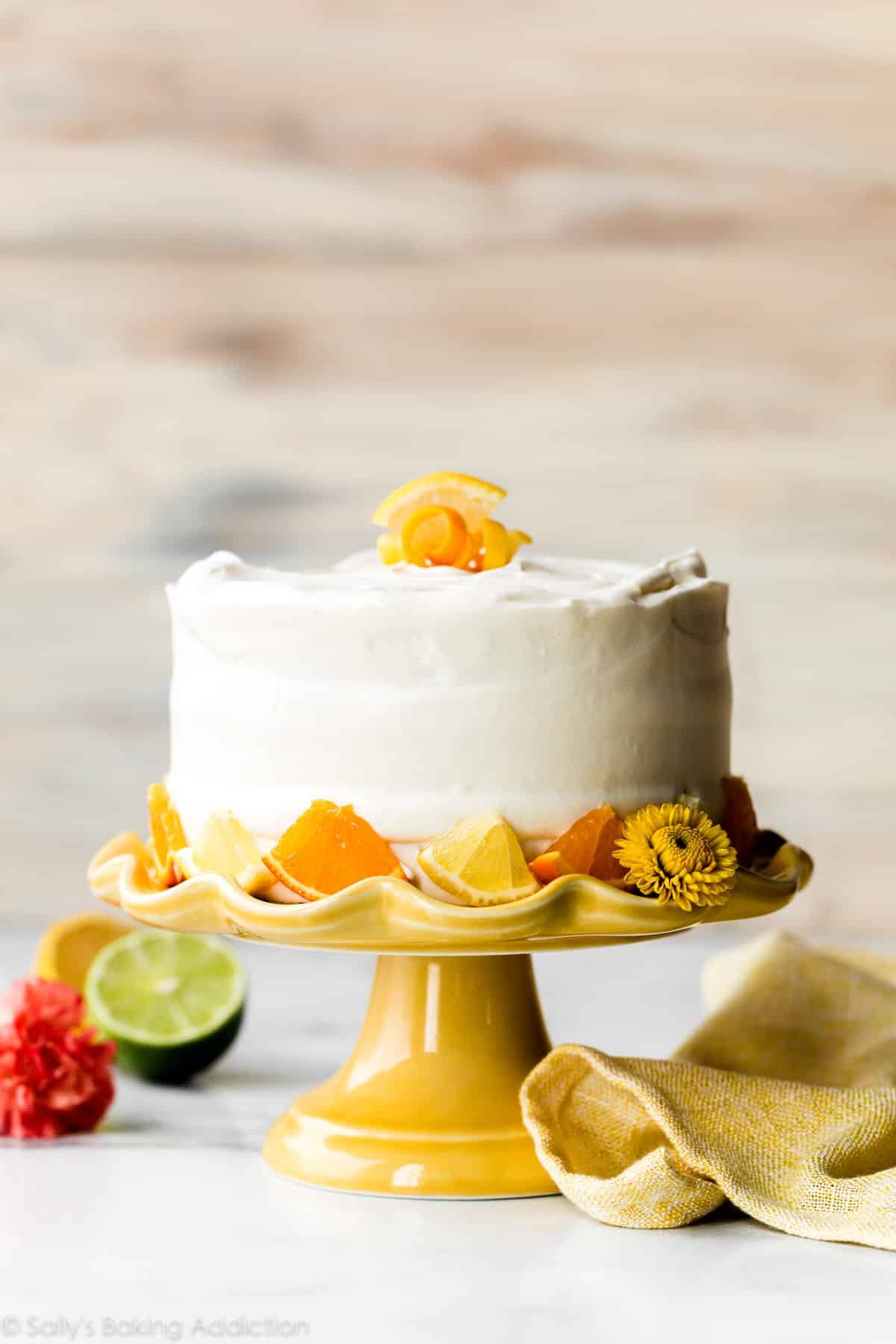
This is Sunshine on a Cake Stand
I endlessly tested this cake recipe during a week of freezing rain and ice, taste tested the final version with a few friends as snow fell outside, and photographed the cake on a cold day with 40mph wind slamming against my window. And so we’re calling it sunshine citrus cake because nothing is more fitting as we yearn for warmer, brighter days ahead!
Sunshine Citrus Cake Details
- Flavor: If you love the sweet, sour, and refreshing flavor of fresh citrus fruits, you will fall in love with today’s cake recipe. Cream butter and sugar together for a minute before adding fresh orange, lemon, and lime zest. In this creaming step, we’re infusing flavor right into the base of the cake. Add fresh-squeezed juice into the batter when you add milk. We’ll also prepare fresh lemon curd which you’ll mix with whipped frosting to fill the cake. You have control over the citrus used, so if you want to skip the orange—go right ahead! You can also add grapefruit, use blood orange, or stick with plain lemon.
- Texture: The crumb is light and springy, but still holds up nicely to the creamy whipped frosting.
- Size: This is a 6-inch 3 layer cake. 6 inch cakes are massively popular right now because they’re a more manageable size. If you have a small family or gathering, there’s not as much leftover plus the smaller size makes for easier assembling, decorating, and serving. If you don’t have 6 inch cake pans, they’re a wonderful size to consider. I use and love (affiliate link) these 6-inch pans. And if you visit my 6-inch cake recipes page, you’ll find dozens of recipes to try!
- Ease: Even though the round layer cake is a smaller size than a traditional 9-inch cake, there are a few steps requiring your focus including making the lemon curd, carefully whipping the frosting, and applying a crumb coat. You can use this detailed how to assemble and decorate a layer cake post as your guide.
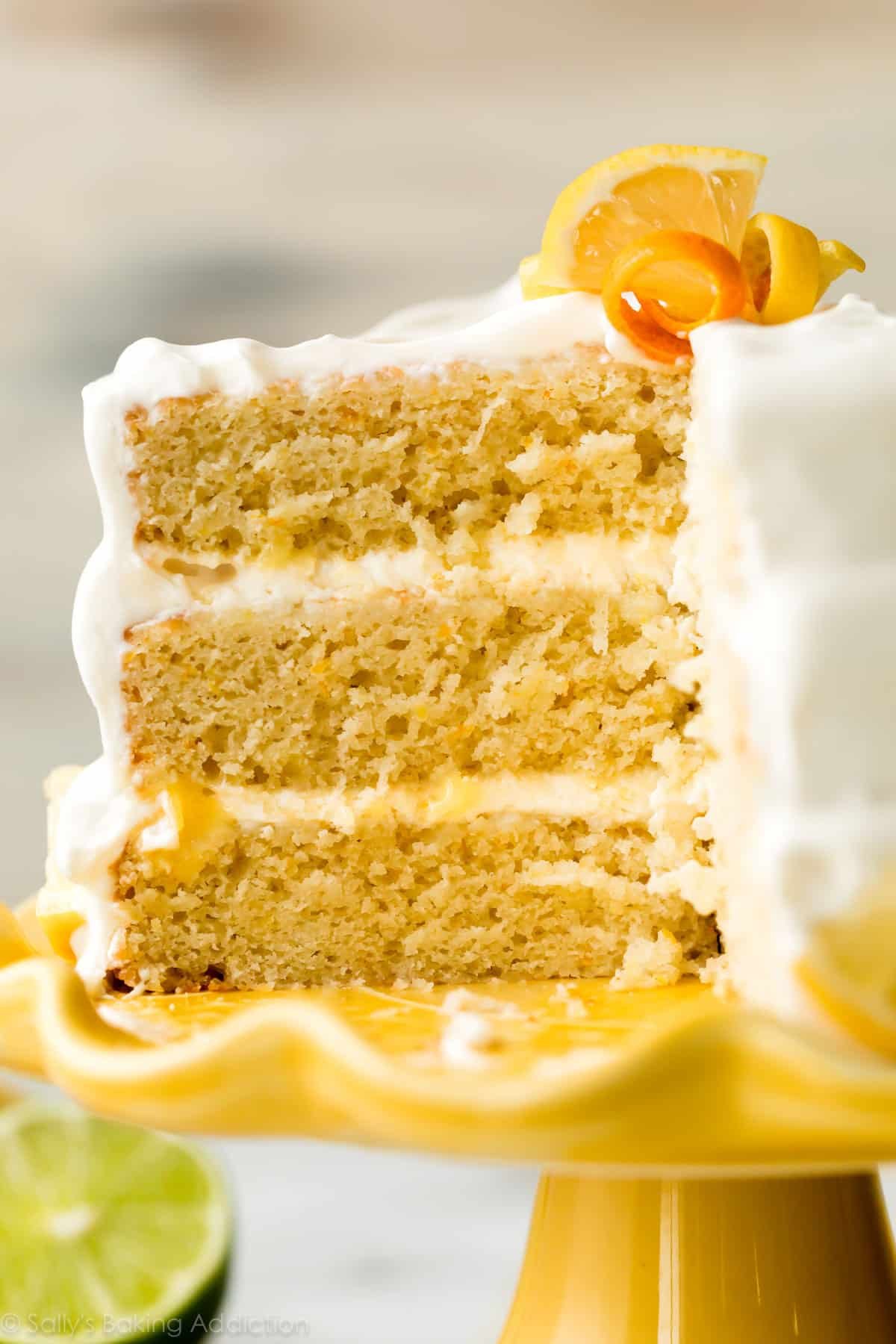
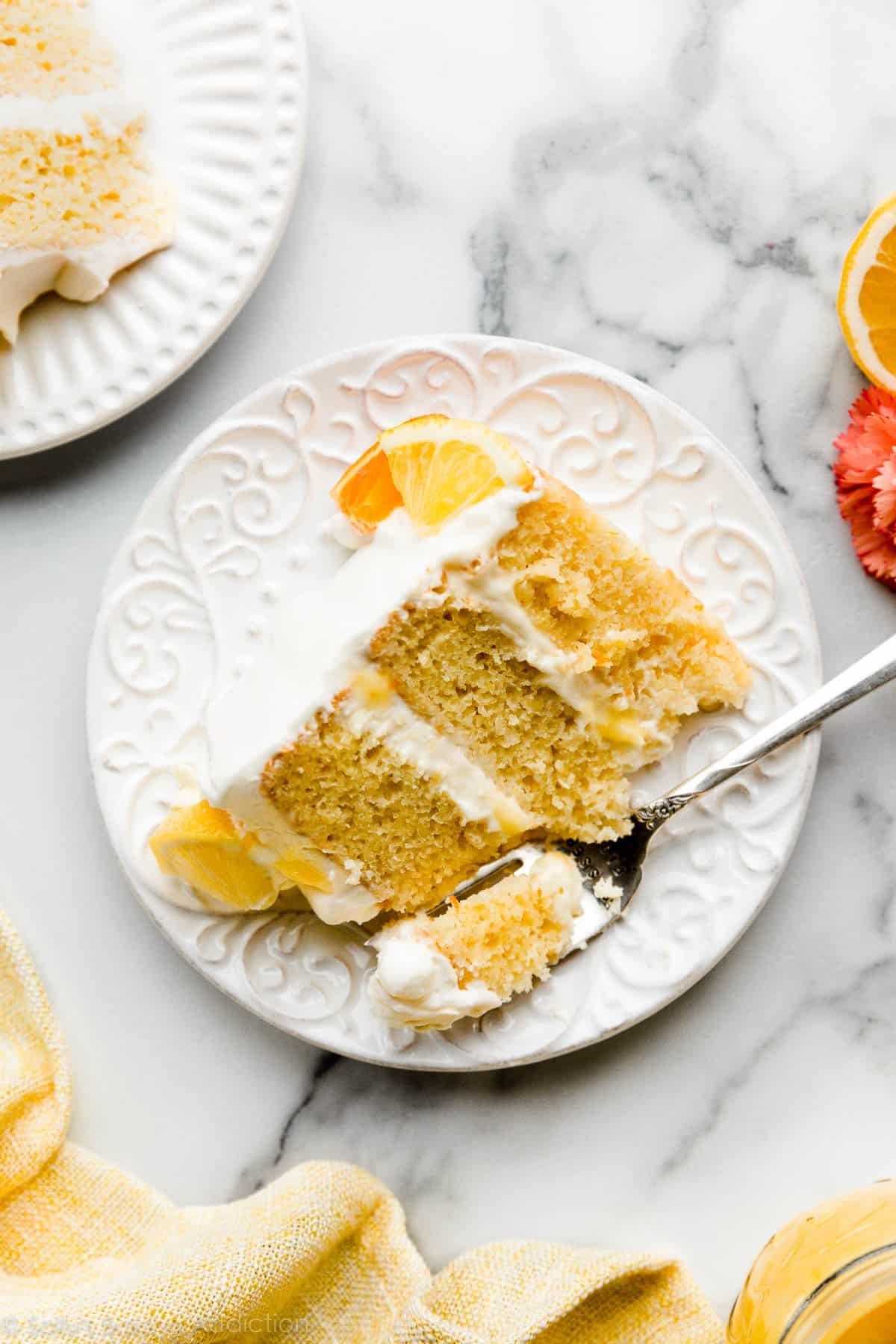
Three Parts to Sunshine Citrus Cake & Why This Recipe Works
This recipe combines citrus cake layers, a lemon curd-infused whipped frosting filling, and plain whipped frosting around the exterior.
- Lemon Curd: Have you ever made lemon curd before? If you’ve prepared lemon bars or lemon meringue pie, you’ve tasted something like it. Lemon curd is a deliciously tangy, creamy, and sweet topping you make on the stovetop that you can pair with scones, quick breads, crepes, and so much more. Homemade lemon curd tastes approximately 1,000x better than store-bought and you only need 5 ingredients to make it. (And all of those ingredients are also needed in the cake! How convenient!) Prepare the lemon curd first because it must cool and thicken. Do you want to use other citrus in the curd? See recipe note below. The pictured cake has orange zest in the curd.
- Citrus Cake Layers: The cake recipe comes from my perfect lemon cupcakes and lemon blueberry cupcakes. The batters are nearly identical except today we’re using a little more flour, plus a combination of citrus and infusing citrus zest into the creamed butter/sugar mixture. Most cupcake recipes yielding 12-15 cupcakes make the perfect amount of batter for a 3 layer 6 inch cake. One dozen cupcakes usually takes about 3-4 cups of cake batter, which divides perfectly between 3 6 inch cake layers.
- Whipped Frosting: Have you tried this not-so-sweet whipped frosting yet? Now is your chance. We’re mixing some of the frosting with lemon curd, which will be the cake’s filling.
For Anyone Interested in the Recipe Testing!
I started with my lemon layer cake recipe. This is an older recipe published on my website and over the past year, I modified it by using smaller cake pans (for thicker layers), more leavener (for fluffier, taller cakes), and whole milk instead of buttermilk (less acidity). You can see those changes in the recipe now. But once I started substituting some lemon zest/juice for other citrus, the flavor disappeared. I find that cake is best as lemon. Period.
I continued testing white cake batters with cake flour and egg whites. (Ingredients I love using in my fluffy white cake.) Results were disappointing. I do NOT want you to use cake flour in this recipe because somehow—and I learned this from multiple rounds of testing—cake flour cannot hold up to the fresh juice unless you add more chemical leavener than you think you need (which can affect the taste) or use less liquid (which produces a thicker batter and denser cake). Using only egg whites dried out the cake and overall, I couldn’t get enough citrus flavor into such a large cake. I guess I have high citrus standards!
Lemon cupcake batter and 6-inch cake pans to the rescue. What a triumph.
Step-by-Step Photos
Make the lemon curd and then let it cool and thicken completely:
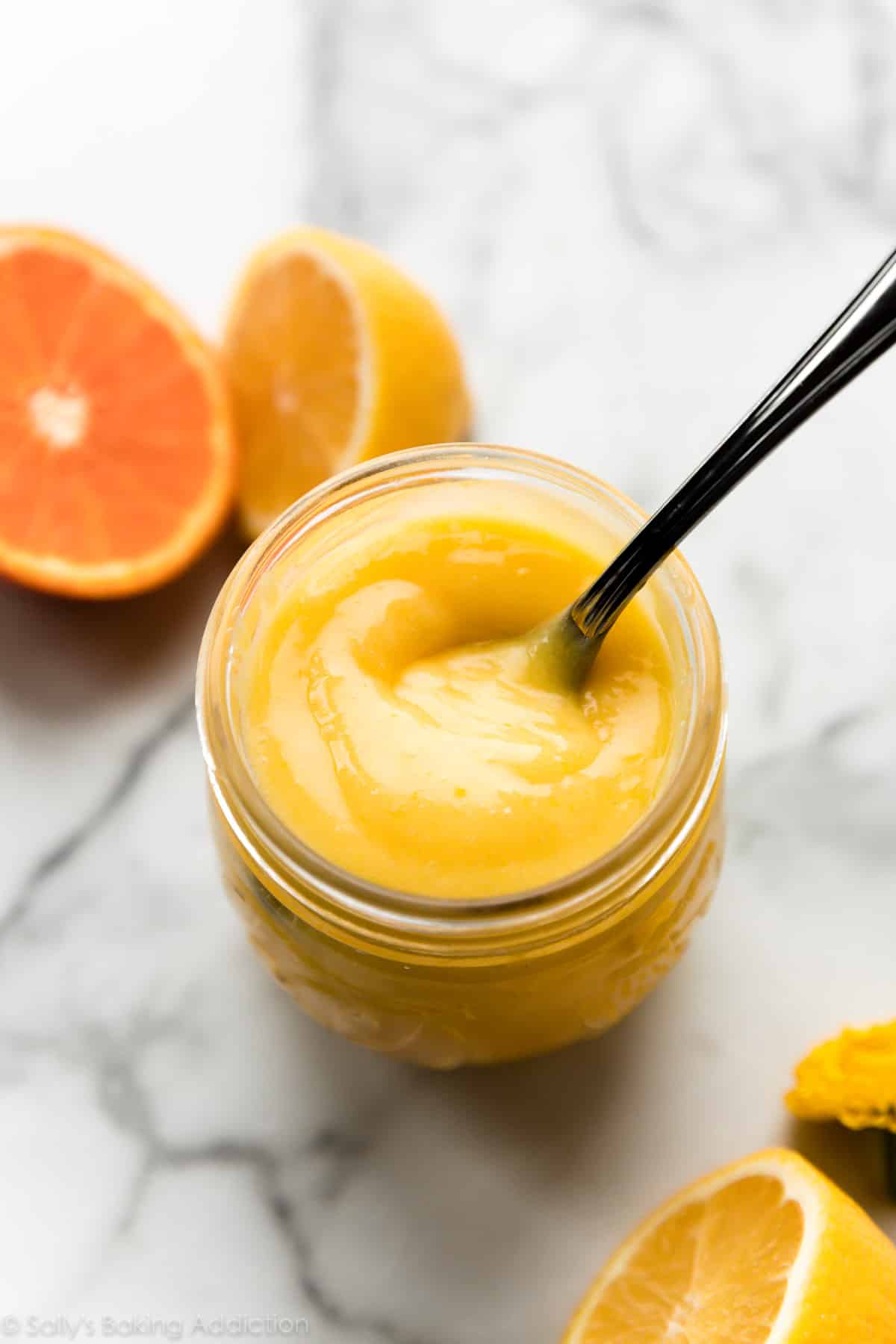
I like this cake flavored with a variety of citrus. You will have between 3.5 – 4 cups of batter and it will be slightly thick with some small lumps:
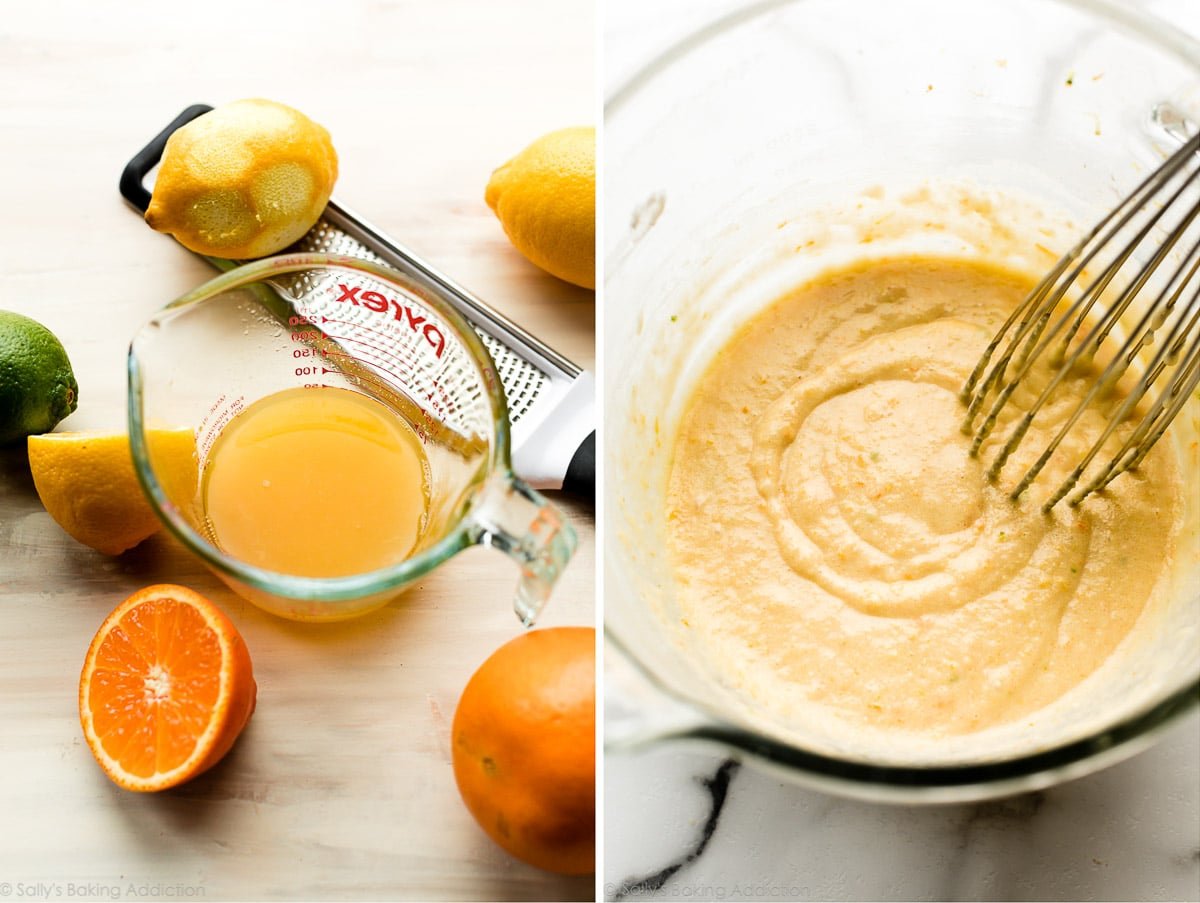
Prepare your 6 inch cake pans by lightly greasing them, lining each with parchment paper rounds, and then lightly greasing the parchment paper. I just use nonstick spray.
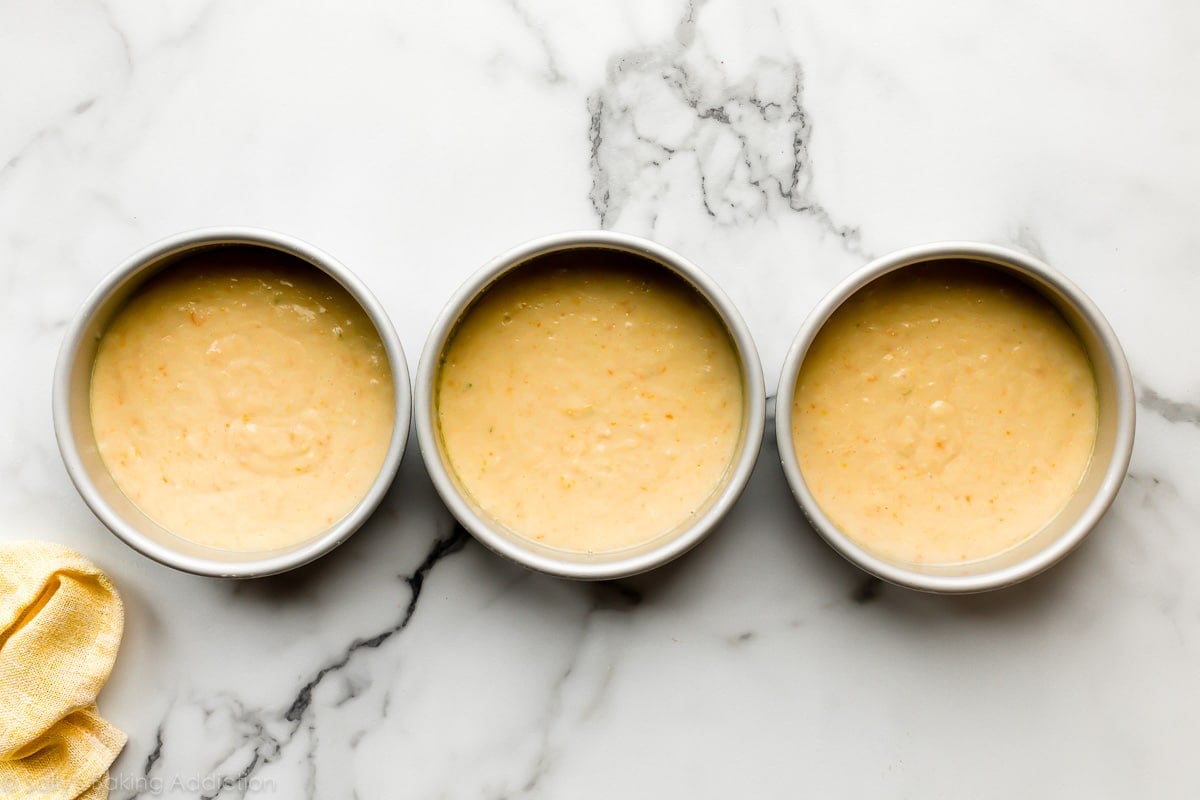
After the cakes bake and cool, prepare your whipped frosting with just 4 ingredients—cream cheese, confectioners’ sugar, vanilla extract, and heavy cream. You will have about 3.5 cups of frosting. Stir 3 Tablespoons of your lemon curd into just under half of your frosting:
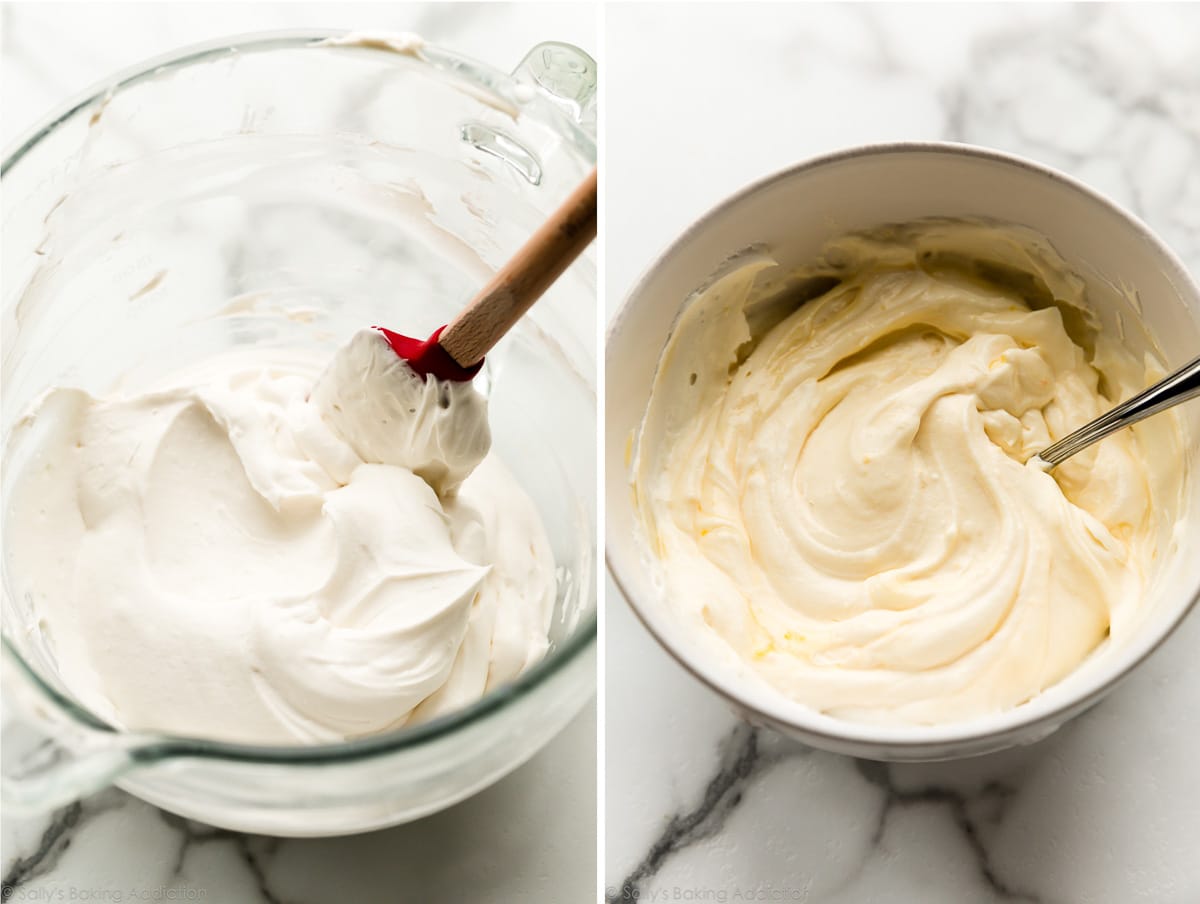
The lemon curd portion of your whipped frosting is the cake’s filling. If you have leftover lemon curd frosting, use it on the exterior of the cake. Apply a crumb coat, which is a thin layer of frosting that “catches” any crumbs, and then refrigerate the cake. Chilling the filled crumb-coated cake establishes its structure. Without time in the refrigerator, your filled and frosted cake will fall apart.
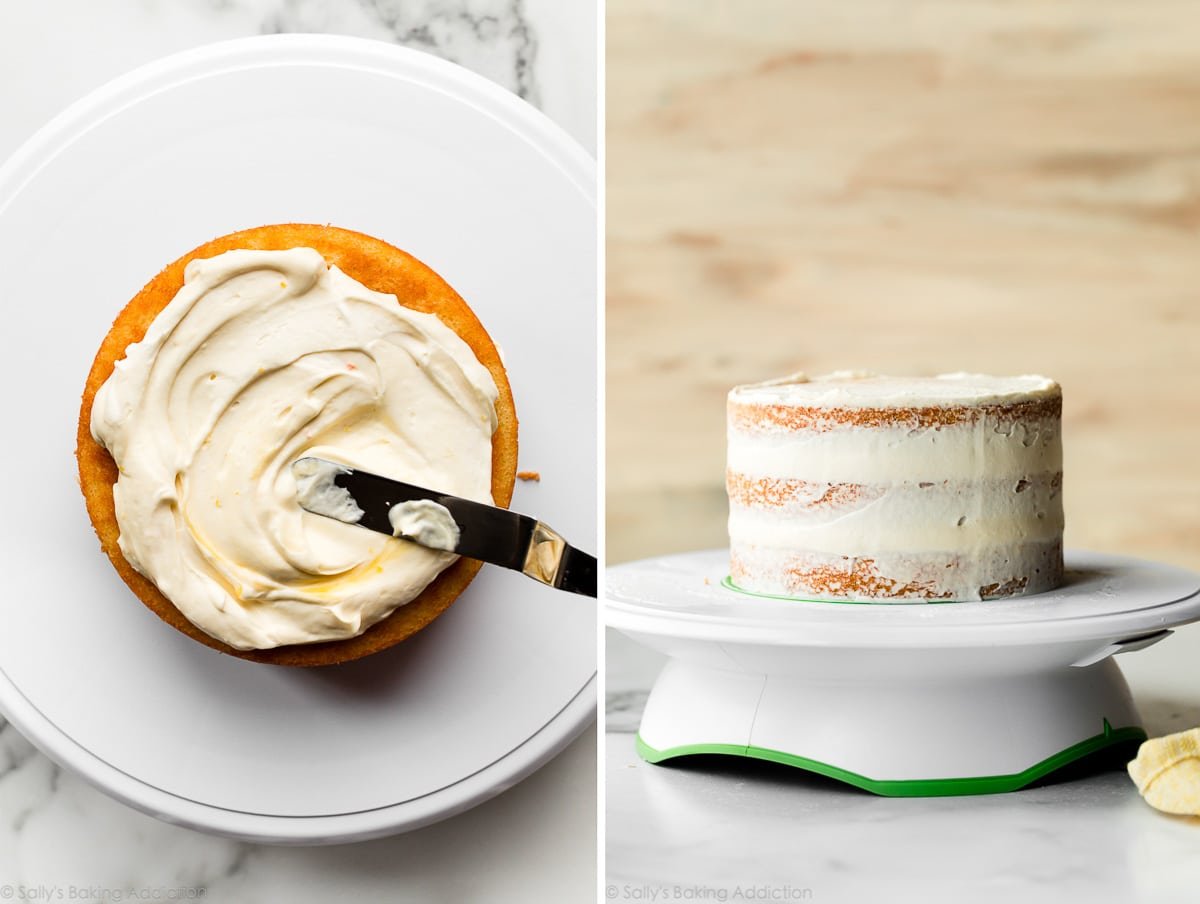
Add the remaining frosting on your chilled crumb-coated cake and if you have any leftover, feel free to pipe some on top. You can even tint the frosting yellow, green, or orange with gel food coloring. The cake pictured above does not have those details, but you can see the piping here with a Wilton 1M tip:
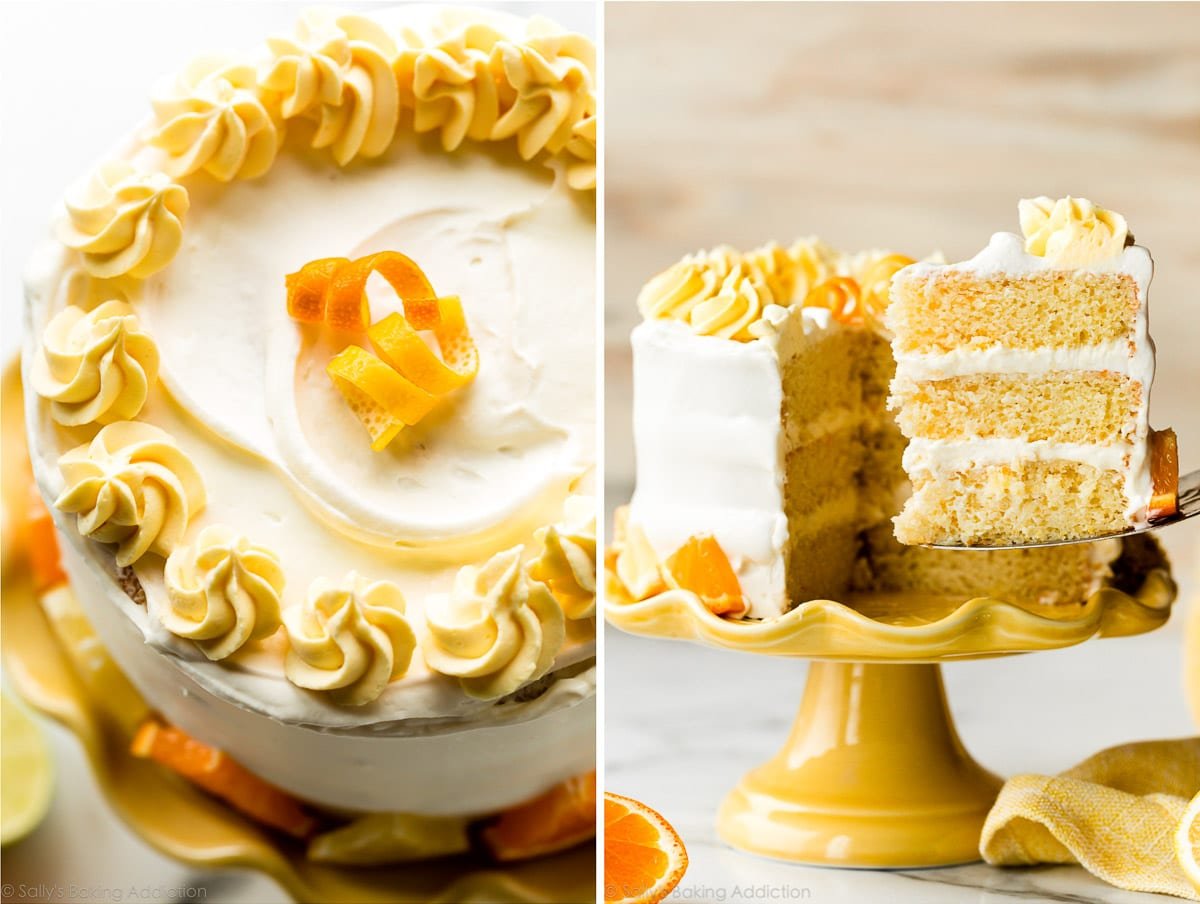
Helpful Tools for Citrus Cake
These are products I use and love and the links below are affiliate links. Most (but not all) of these tools are optional, so you can still make the recipe without them.
- Double Boiler: Cook the lemon curd over indirect heat using a double boiler on the stove. Lemon curd may have a metallic aftertaste if you cook it in a metal double boiler. It’s a result of the eggs and lemon reacting with the pan, but is easily avoidable! Use a non-metal double boiler (this one has a porcelain insert) or the glass bowl option I mention in the recipe notes (but make sure it’s heatproof glass, like Pyrex).
- Silicone Whisk: You can get away without many of the items in this list, but I do strongly recommend a silicone whisk for the curd. Metal whisks can leave an aftertaste.
- 6×2-Inch Cake Pans: I use and love these 6-inch round cake pans. If you do not have 6 inch pans and still want to make this recipe, turn the cake into cupcakes. See detailed notes below.
- Citrus Zester or Grater: A good portion of flavor comes from the citrus zest in the lemon curd and in the cake batter, so this tool is a necessity. I use and love this citrus zester. A cheese grater on a fine grating setting or a microplane work too.
- Citrus Juicer: Of course you can just squeeze out the juice by hand, but if you love baking or cooking with citrus or enjoy fresh-squeezed juice, a citrus juicer is convenient!
- Cake Turntable: A cake turntable makes it easy to frost the sides of a cake when applying the crumb coat and final layer of frosting. You can watch me use it in the video below. The green one I use is no longer available.
- Bench Scraper: I like to run a bench scraper around the sides of the cake to smooth out the frosting. This works for any size cake. If you’ve never used one before to decorate a cake, you can watch me use it in the video below. They’re very handy!
- Icing Spatula(s): Use a small icing spatula for spreading the frosting between the layers and on top of the cake. I also use a larger flat icing spatula before using the bench scraper. Icing spatulas are optional, but if you decorate cakes and cupcakes often, they’re great tools.
- Small Cake Stand: I bought the pictured yellow cake stand from Home Goods a few years ago. Look for a cake stand that’s about 8 inches in diameter so it can fit the 6 inch size with a little room to spare.
That was a lot of information to prep you! If you made it down this far, you’re completely ready to begin this recipe. I hope you love this drop of sunshine.
See Your Sunshine Citrus Cakes!
Many readers tried this recipe as part of a baking challenge! Feel free to email or share your recipe photos with us on social media. 🙂
Print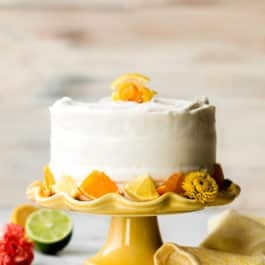
Sunshine Citrus Cake
- Prep Time: 1 hour (plus lemon curd cooling)
- Cook Time: 20 minutes
- Total Time: 5 hours, 20 minutes (includes cooling)
- Yield: serves 8
- Category: Dessert
- Method: Baking
- Cuisine: American
Description
This sunshine citrus cake cures the cold weather blues with bright flavor, a light and springy cake crumb, and creamy whipped frosting. Be sure to set aside enough time to prepare the lemon curd in advance.
Ingredients
Lemon Curd
- 2 large egg yolks
- 1 large egg
- 2/3 cup (134g) granulated sugar
- 1 Tablespoon lemon zest (about 1 lemon)
- 1/3 cup (80ml) fresh lemon juice (about 2–3 lemons)
- 1/8 teaspoon salt
- 6 Tablespoons (85g) unsalted butter, softened to room temperature
Cake
- 1 and 3/4 cups (219g) all-purpose flour (spooned & leveled)
- 2 teaspoons baking powder
- 1/2 teaspoon salt
- 1/2 cup (8 Tbsp; 113g) unsalted butter, softened to room temperature
- 1 cup (200g) granulated sugar
- 1 and 1/2 Tablespoons citrus zest (combination of lemon, orange, and lime or other, see note)
- 2 large eggs, at room temperature
- 1 and 1/2 teaspoons pure vanilla extract
- 1/2 cup (120ml) whole milk, at room temperature
- 1/3 cup (80ml) freshly squeezed citrus juice (combination of lemon, orange, and lime or other, see note)
Whipped Frosting
- 6 ounces (170g) full-fat brick cream cheese, softened to room temperature
- 3/4 cup (90g) confectioners’ sugar
- 1 and 1/2 teaspoons pure vanilla extract
- 1 and 1/2 cups (360ml) cold heavy cream or heavy whipping cream (very cold!)
- optional: sliced citrus fruits or citrus twists to garnish
Instructions
- Make the lemon curd: Fill the bottom pot of your double boiler with 1-2 inches of water. (Or use the DIY double boiler method listed in the notes.) Place on high heat. Once the water begins to boil, reduce to low heat to keep the water at a simmer. Place egg yolks, egg, granulated sugar, lemon zest, lemon juice, and salt into the top pot of your double boiler. Using a silicone whisk (avoid metal because it leaves an aftertaste), whisk until completely blended and then continue to whisk as the curd cooks. Whisk and cook until the mixture becomes thick and is the consistency of hollandaise sauce or a really thick soup, about 10 minutes or when an instant read thermometer reaches 160°F (71°C). If curd isn’t thickening, turn up the heat and constantly whisk. Remove pan from heat. Cut the butter into 6 separate pieces and then whisk into the curd until butter has melted and combined. Pour curd into a jar or bowl and place a piece of plastic wrap directly on top so it is touching the top of the curd. This prevents a skin from forming on top. The curd will continue to thicken as it cools. Place in refrigerator to speed up cooling. Once cool, the plastic wrap can be removed. Refrigerate the curd for up to about 10 days or for longer storage, you can freeze the cooled curd for up to 3-6 months. Thaw in the refrigerator overnight before enjoying. Makes 1 heaping cup.
- Make the cake: Preheat oven to 350°F (177°C). Grease three 6-inch round cake pans, line with parchment paper rounds, then grease the parchment paper. Parchment paper helps the cakes seamlessly release from the pans. (If it’s helpful, see this parchment paper rounds for cakes video & post.)
- Whisk the flour, baking powder, and salt together in a medium bowl. Set aside. Using a handheld or stand mixer fitted with a paddle or whisk attachment, beat the butter and sugar together on medium-high speed until combined, about 1 minute. Scrape down the sides and up the bottom of the bowl with a rubber spatula and then add the citrus zest. Beat on medium-high speed until combined and creamy, about 2 minutes. Add the eggs and vanilla extract. Beat on medium-high speed until combined. Scrape down the sides and up the bottom of the bowl and beat again as needed to combine. Add half of the flour mixture (just eyeball it), half of the milk, and half of the citrus juice. Beat on low speed until mostly combined, and then add the remaining flour mixture, milk, and citrus juice. Beat on low speed until combined. Do not over-mix. You may need to whisk it all by hand to make sure there are no large lumps at the bottom of the bowl. The batter will be slightly thick with some small lumps. You will have between 3.5 – 4 cups of batter.
- Divide and pour batter evenly into cake pans. If batter appears to have bubbles, give the pans a light tap on the counter to pop them. Bake cakes for 18-21 minutes or until baked through. To test for doneness, insert a toothpick into the center of the cake. If it comes out clean, it’s done.
- Allow cakes to cool completely in the pans set on a wire rack for 30 minutes. Remove cakes from the pans and set them on a wire rack to cool completely. The cakes must be completely cool before frosting and assembling.
- Make the whipped frosting: In a large bowl using a hand-held mixer or stand mixer fitted with a whisk or paddle attachment, beat the cream cheese on medium-high speed until creamy, about 1 minute. Scrape down the sides and up the bottom of the bowl and beat again as needed until creamy. Add the confectioners’ sugar and vanilla extract, and then beat on medium speed until combined and completely smooth (absolutely no lumps), at least 2 full minutes. Scrape down the sides and up the bottom of the bowl and beat again as needed to smooth out. Switch to a whisk attachment (if you haven’t already been using it). Turn the mixer to low speed and with the mixer running, carefully pour in the cream in a slow and steady stream. After all of the cream has been added, turn the mixer up to high speed and whip until thick and stiff peaks form, about 1-2 minutes. Do not walk away during this time and do not be concerned if your frosting takes longer to whip. You’re looking for a thick, airy consistency with stiff peaks. If your frosting appears soupy now or at any point you are working with it, it needs more whipping to introduce more air. If your frosting appears chunky or curdled, it’s over-whipped. To fix, stir 1 Tablespoon of heavy cream into the frosting by hand to smooth out again. You will have about 3.5 cups of frosting.
- Make lemon curd frosting filling: Spoon 1 cup of frosting (about 240ml) into a separate bowl. Stir in 3 heaping Tablespoons of cooled lemon curd. This will be your filling for the cake. Enjoy remaining lemon curd drizzled on the cake slices or as a topping on other baked goods.
- Assemble & crumb coat the cake: First, make sure you have enough room for the cake inside your refrigerator because it must chill at the end of this step and briefly in the next step as well. If the cake layers aren’t flat on top, carefully and slowly level them off using a large serrated knife. Discard (or crumble over ice cream!). Place 1 cake layer on your cake stand, cake turntable, or serving plate. Evenly cover the top with 1/2 of the lemon curd frosting. Top with 2nd cake layer and evenly cover the top with remaining lemon curd frosting (if you have extras, just use it on the exterior of the cake). Top with the third cake layer. Spread a very thin layer of regular whipped frosting on top and all around the sides of the cake to create a crumb coat. A bench scraper and small icing spatula are handy for this. Refrigerate uncovered for 30 minutes.
- Add remaining frosting on chilled crumb-coated cake using a small icing spatula or a larger flat icing spatula. Use a bench scraper, if desired, to smooth out the sides. Refrigerate the decorated cake uncovered for at least 30 minutes to help set the frosting. After that, if you used a cake turntable, you can carefully transfer the cake to a cake stand or serving plate using a couple flat spatulas.
- After 30 minutes in the refrigerator, the decorated cake is fine to slice and serve or sit out at room temperature for a few hours. Cover leftover cake tightly and store in the refrigerator for 5 days.
Notes
- Make Ahead Instructions: To make the lemon curd ahead of time or to freeze it, see end of step 1. The cake layers can be baked, cooled, and covered tightly at room temperature overnight. Making the frosting ahead of time can be tricky because it doesn’t sit well in the bowl overtime. Instead, make the frosting and use it immediately on the cake. After you finish decorating the cake in step 9, refrigerate for at least 30 minutes as instructed. You can extend this time up to 1 full day. After 2 hours, though, I recommend lightly covering the cake. (Note that covering this frosting can get messy and I haven’t found a workaround for that.) Let cold cake sit at room temperature for about 1 hour before serving.
- Freezing Instructions: Frosted cake or unfrosted cake layers can be frozen up to 2-3 months. To freeze the frosted cake, refrigerate for at least 1 hour to set the frosting, and then cover and freeze for up to 3 months. Thaw your cake at room temperature.
- Special Tools (affiliate links): Double Boiler | Silicone Whisk | Citrus Zester or Microplane | Citrus Juicer | 6-inch Round Cake Pans | Electric Mixer (Handheld or Stand) | Cake Turntable | Bench Scraper | Small Icing Spatula | Large Flat Icing Spatula | Cake Carrier (for storage)
- Eggs & Citrus in the Lemon Curd: I typically prepare lemon curd using 4 egg yolks, however I find the final consistency thicker when using 2 egg yolks and 1 whole egg—that is reflected in the recipe above. You can make the lemon curd as written, but if you’d like to switch citrus flavors, I recommend a 1:1 substitution with lime juice and zest. If you want to make grapefruit or orange curd, I recommend only substituting half of the lemon juice/zest. Make sure you use fresh-squeezed citrus.
- DIY Double Boiler for Curd: If you do not own a double boiler, you can simply place a small heatproof glass bowl over a saucepan of simmering water—you will cook the curd in the top pot/bowl.
- Best Citrus to Use in Cake: This cake is best with just lemon, just lime, or a combination of both or either of those with another citrus such as orange, blood orange, or grapefruit. I don’t recommend skipping the lemon or lime because other citrus flavors don’t come through very much on their own. I like using an equal combination of lemon, lime, and orange.
- Cream Cheese in Frosting: Do not use cream cheese spread and do not use the entire 8 ounce brick—you only need 6 ounces. Make sure it is full fat. I have best luck with Philadelphia brand cream cheese in this frosting.
- Amount of Cake Batter & Other Size Cakes or Cupcakes: This recipe yields between 3.5 – 4 cups of batter, which is helpful if you need it for different Cake Pan Sizes & Conversions. Because of its light yet moist texture, this cake is best as a layer cake or as cupcakes. I have not tested this as a 1 layer 9-inch cake. For a 3 layer 8-inch cake, I recommend making this lemon layer cake instead and scaling up the frosting by using one 8-ounce (225g) block cream cheese, 1 cup (120g) confectioners’ sugar, 2 teaspoons vanilla extract, and 1 and 3/4 cups (420ml) heavy cream. Keep the lemon curd amount the same since this recipe makes plenty. Feel free to use a combination of citrus in that cake, but be warned that no flavor comes through quite like lemon. I strongly encourage you to keep that cake as a lemon flavored cake. For 1 dozen cupcakes, fill cupcake liners 2/3 full. Bake at 350°F (177°C) for 18-22 minutes. A toothpick inserted in the middle will come out clean when they’re done. After cupcakes cool, carve a hole in the center (like I do for these chocolate covered strawberry cupcakes) and fill with 1 heaping teaspoon lemon curd. Top with whipped frosting. Feel free to mix some lemon curd into the frosting, too.


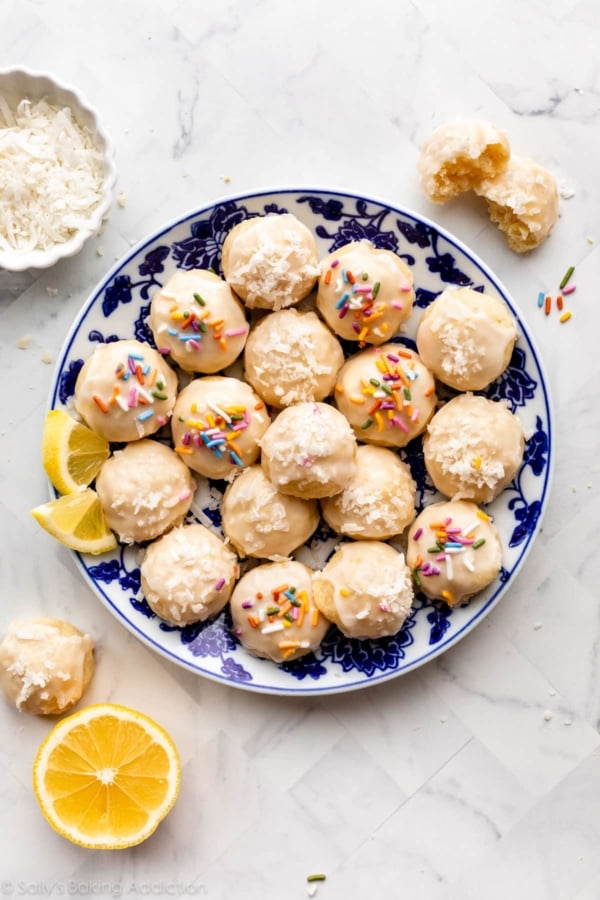














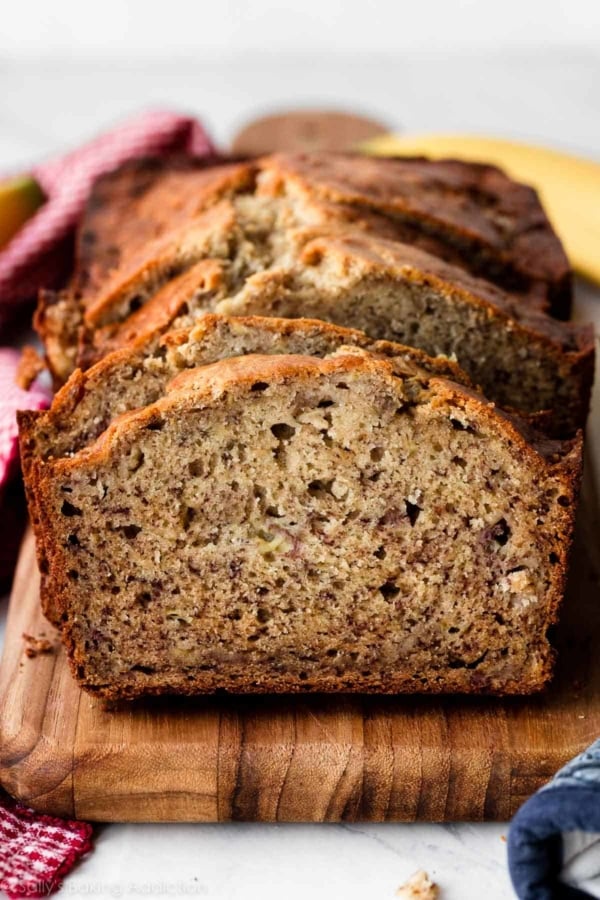

Reader Comments and Reviews
Hi Sally could this be made into a Bundt?
Hi Martina, this recipe doesn’t yield enough batter for a regular large Bundt pan. However, we’re sure you could divide it up to make mini cakes with a mini Bundt pan. For a citrus Bundt cake, try this lemon poppy seed Bundt! You could use a variety of citrus in that recipe too.